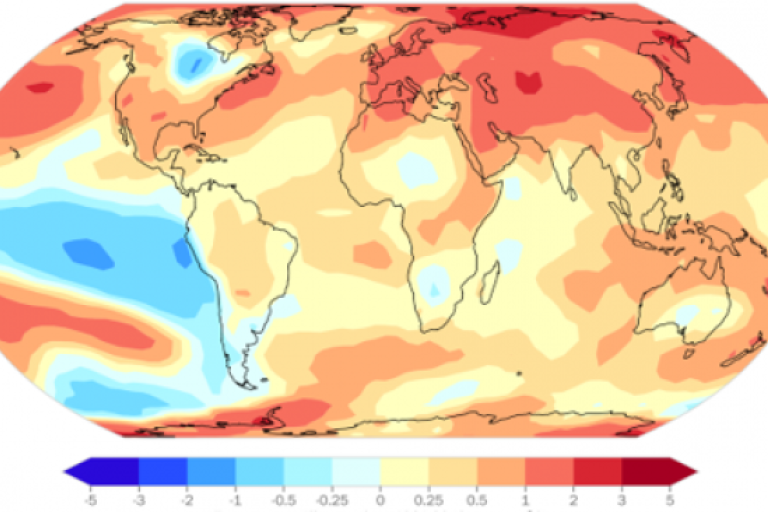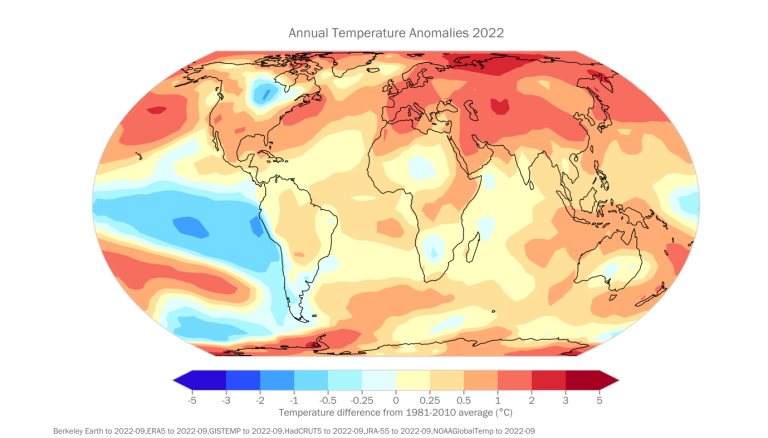Eight warmest years on record witness upsurge in climate change impacts

Sharm-El-Sheikh, Egypt (WMO) - The past eight years are on track to be the eight warmest on record, fuelled by ever-rising greenhouse gas concentrations and accumulated heat. Extreme heatwaves, drought and devastating flooding have affected millions and cost billions this year, according to the World Meteorological Organization’s provisional State of the Global Climate in 2022 report.

The tell-tale signs and impacts of climate change are becoming more dramatic. The rate of sea level rise has doubled since 1993. It has risen by nearly 10 mm since January 2020 to a new record high this year. The past two and a half years alone account for 10 percent of the overall rise in sea level since satellite measurements started nearly 30 years ago.
2022 took an exceptionally heavy toll on glaciers in the European Alps, with initial indications of record-shattering melt. The Greenland ice sheet lost mass for the 26th consecutive year and it rained (rather than snowed) there for the first time in September.
The global mean temperature in 2022 is currently estimated to be about 1.15 [1.02 to 1.28] °C above the 1850-1900 pre-industrial average. A rare triple-dip cooling La Niña means that 2022 is likely to “only” be fifth or sixth warmest. However, this does not reverse the long-term trend; it is only a matter of time until there is another warmest year on record.
Indeed, the warming continues. The 10-year average for the period 2013-2022 is estimated to be 1.14 [1.02 to 1.27] °C above the 1850-1900 pre-industrial baseline. This compares with 1.09°C from 2011 to 2020, as estimated by the Intergovernmental Panel on Climate Change (IPCC) Sixth Assessment report.
Ocean heat was at record levels in 2021 (the latest year assessed), with the warming rate particularly high in the past 20 years.
“The greater the warming, the worse the impacts. We have such high levels of carbon dioxide in the atmosphere now that the lower 1.5°C of the Paris Agreement is barely within reach,” said WMO Secretary-General Prof Petteri Taalas.
“It’s already too late for many glaciers and the melting will continue for hundreds if not thousands of years, with major implications for water security. The rate of sea level rise has doubled in the past 30 years. Although we still measure this in terms of millimetres per year, it adds up to half to one meter per century and that is a long-term and major threat to many millions of coastal dwellers and low-lying states,” he said.
“All too often, those least responsible for climate change suffer most – as we have seen with the terrible flooding in Pakistan and deadly, long-running drought in the Horn of Africa. But even well-prepared societies this year have been ravaged by extremes – as seen by the protracted heatwaves and drought in large parts of Europe and southern China,” said Prof. Taalas.
“Increasingly extreme weather makes it more important than ever to ensure that everyone on Earth has access to life-saving early warnings.”
WMO released the provisional State of the Global Climate report and an accompanying interactive storymap on the eve of the UN climate negotiations in Sharm-El-Sheikh, COP27. UN Secretary-General Antonio Guterres will unveil an Action Plan at COP27 to achieve Early Warnings for All in the next five years. Currently half the countries in the world lack these. Mr Guterres has asked WMO to spearhead the initiative.
The WMO State of the Global Climate report is produced annually. It provides an authoritative voice on the current state of the climate using key climate indicators and reporting on extreme events and their impacts. The temperature figures used in the provisional 2022 report are until the end of September. The final version will be issued next April.










